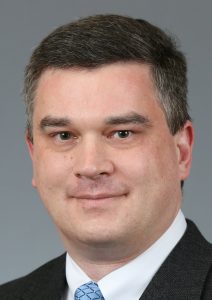Timothy Capstack to Highlight Workforce Management of PAs and NPs
Physician to Discuss Provider-Specific Data at ELC
July 25, 2018
By Jennifer Walker
As Director of Clinical Integration at Adfinitas Health in Hanover, Maryland, Timothy Capstack, MD, FACP, SFHM, is responsible for managing the company’s 200-person PA and nurse practitioner (NP) workforce. What is workforce management? The term refers to managing the activities that are needed to maintain a productive workforce— for example, training and education programs and opportunities for advancement—while also focusing on financial efficiency.

“In other words,” says Capstack, who is also a partner at Adfinitas Health, “not costing more than you need to cost, but at the same time making sure you have adequate and sufficient staffing to provide safe and effective patient care.”
Collecting data that is broken down by provider group can help hospital leaders more effectively manage their workforce. At the Center for Healthcare Leadership and Management (CHLM)’s Executive Leadership Conference in November, Capstack will lead the session “Measuring Your Workforce/ Outcomes Research.” He is developing the content with CHLM director Bianca Belcher, PA-C, MPH, and will focus on collecting data specifically for PAs and NPs. “If you’re able to collect the data that relates to PAs and NPs, you’re able to act on that data in whatever way needs to be done to make improvements,” he says.
A Path to Leadership
In 1998, Capstack began his career as a hospitalist working at Eastern Maine Medical Center in Bangor, Maine. A decade later, he joined a private practice hospitalist group called Physician Inpatient Care Specialists (MDICS), where he was on the partnership track. “It was a new company at the time, and it came with an ownership interest in the practice itself. That was appealing to me,” he says. Capstack began providing care at Anne Arundel Medical Center in Annapolis, Maryland, where he became the lead hospitalist after only one year. In this role, he managed 25 people, including 10 physicians and 15 PAs and NPs; provided quality control; and worked with hospital administration to further their objectives.
In 2013, Capstack moved up to become Regional Director with MDICS. Then, in addition to his role at Anne Arundel Medical Center, he also became responsible for the financial and administrative oversight of three other MDICS programs located on Maryland’s Eastern Shore.
Today, at Adfinitas Health—MDICS was renamed Adfinitas Health in January 2017—Capstack is responsible for incorporating the company’s PAs and NPs into its hospitalist practice, which is based at 15 hospitals located in Maryland, Michigan, Pennsylvania, and Virginia. Capstack sets up student rotations, manages the company’s internal training program and its collaborative framework with physicians, and develops educational materials.

Collecting Provider-Specific Data
Adfinitas Health had been comfortable using PAs and NPs for years, but the company wanted to explore whether this care model was as good as they thought it was, Capstack says. So Capstack began collecting data that specifically related to PAs in 2012; the resulting study was published in the Journal of Clinical Outcomes Management in 2016. Providers at a 384-bed community hospital were split into two groups, one that had an expanded PA group with three physicians and three PAs, and the other that had a conventional PA group with nine physicians and two PAs. Data was collected for 16,964 patients between January 2012 and June 2013, and the PAs participated in a comprehensive training program as part of the study. A formal collaboration framework was also in place to govern the interaction between the PAs and the physicians. Capstack found no significant difference between the two groups for several patient outcomes, including mortality in the hospital, readmission rates, and length of stay. In addition to this, the expanded PA group had another advantage: it provided the same level of care at a lower cost.
“The data supported our intuition,” Capstack says. “We were then able to use the peer-reviewed study to confirm that finding to our clients and to continue to grow our successful business model.”
Managing the PA and NP Workforce

Adfinitas Health has continued to require that PAs and NPs who are new to hospital medicine participate in the same training program that was used in Capstack’s study. This program includes about 60 hours of lecture-style education based on the 21 core competencies developed by the Society of Hospital Medicine, including asthma, heart failure, pain management, and stroke. PAs and NPs also participate in a six-month bedside training program, providing patient care alongside an experienced physician or PA.
Capstack says the company also offers several leadership opportunities for PAs and NPs. These roles include lead hospitalists, who oversee other PAs and NPs for particular departments; clinical documentation improvement specialists, who focus on billing and coding of electronic medical records; and directors of observation units, who coordinate with hospital administration and nursing staff on protocols along with providing patient care. “A lot of times, we’re able to tailor a position to a PA’s interests,” he says.
Why attend Executive Leadership Conference?
For PAs who are interested in leadership, Capstack says the CHLM Executive Leadership Conference will be helpful in educating attendees about topics that generally are not covered in school curriculums. “People may not have had experience in areas like compensation and managing people,” he says. “These types of conferences are generally very helpful at [providing] at least an introduction to those sorts of subjects.”
Jennifer Walker is a freelance writer in Baltimore, MD. Contact Jennifer at [email protected].
Thank you for reading AAPA’s News Central
You have 2 articles left this month. Create a free account to read more stories, or become a member for more access to exclusive benefits! Already have an account? Log in.
